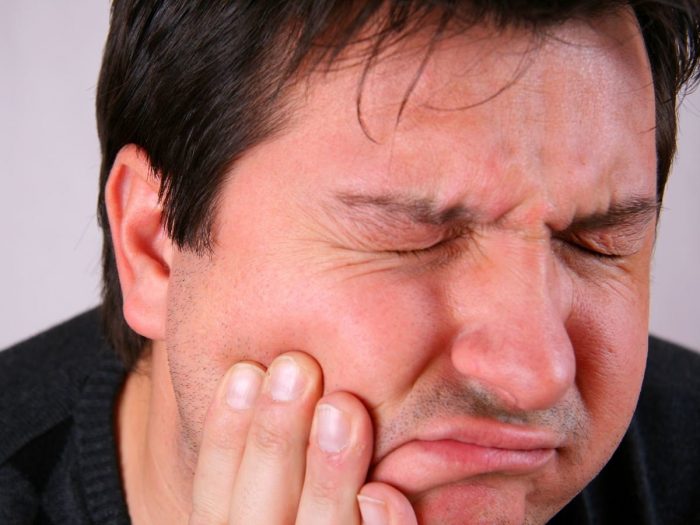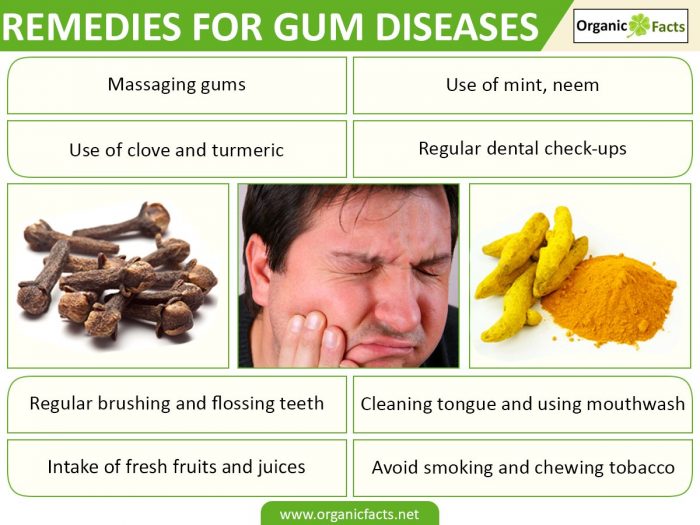Home remedies for gum diseases or periodontal diseases include regular oral hygiene, regular brushing, and flossing of the teeth, using clove and mint, using an antimicrobial mouthwash, massaging of the gums, and quitting smoking.
The primary objective of a person should be to control and reduce the infection that has already been caused. The treatment options would vary depending on the type and severity of the gum disease you are suffering from. Maintaining excellent oral hygiene and careful periodontal monitoring is very important when people notice changes in their mouth. Changes in lifestyle behaviors, such as smoking and chewing tobacco also become important to improve the results of simple home remedies.
Home Remedies for Gum Diseases
Some home remedies for gum diseases include the following:
Brushing
According to NIDCR and the American Dental Association (ADA), brushing the teeth twice a day is suggested. The ADA recommends twice-daily brushing because most individuals are unable to remove the plaque biofilm at one go and hence brushing a second time improves plaque removal. It is more beneficial when there is fluoride content present in the toothpaste that you use. The suggested brushing time of teeth should be 2 minutes, twice daily. Ensure proper brushing of the gum line as well, since most of the plaque that can cause infections is present at the junction of gums and teeth also called dento-gingival junction. [1] [2] [3]

Toothache Photo Credit: Shutterstock
- Placing the brush on the teeth, with the bristle tips pointing towards the gums and placed at an angle of 45 degrees to the long axis of the teeth.
- Exert gentle vibratory pressure using short, back-and-forth motions moving across all the teeth.
- Remember to replace your brush every 3-4 months or when the bristles are frayed.
Flossing
Flossing your teeth regularly helps in reducing gingivitis and is the most recommended tool for removing plaque biofilm. By simply sliding 12 to 18 inches of floss, held tightly between the thumb and forefinger, up and down between the teeth, you can reach those places that are difficult for a brush to reach, thereby removing the plaque. [4] [5]
Clean Your Tongue
If there is the extensive accumulation of bacteria on the tongue, cleaning your tongue should be emphasized. Proper scraping on the surface of the tongue is recommended after every meal. This will remove excess bacteria and prevent bad breath. Use a good quality tongue cleaner and scrape gently from the back to the front of your tongue to ensure a clean, bacteria-free tongue and get rid of malodor. [6]
Use Mouthwash
The use of antimicrobial mouthwash is beneficial in preventing and reducing gingivitis and plaque. A study published in the Journal of Clinical Periodontology enumerates various trials which support the use of chlorhexidine and essential oil mouthwashes, concluding in the end that both the mouthwashes are effective agents for controlling plaque and gingivitis. However, always consider recommendations from your dentist before choosing a specific mouthwash. [7] [8]
Fruit Juices
Fruits and fruit juices are good for keeping the human body healthy. According to a review article, pomegranate contains agents like polyphenolic flavonoids, which exert actions that are conducive to good oral health, particularly in the prevention of gingivitis. The consumption of fruit juices such as oranges and grapes has a positive impact on reducing plaque. [9] [10]
Cloves
Cloves are known to be beneficial for gum health. Using cloves is an age-old and easy home remedy for any kind of dental problems. Clove oil, being an analgesic and having antiseptic properties, is highly effective in both relieving the pain caused by the gum disease and healing the infection at the same time. [11] [12]
Turmeric Powder
Michael Tierra, co-author of “The Way of Ayurvedic Herbs”, highlighted that turmeric contains strong anti-inflammatory and antioxidant properties, making it an effective and excellent medicine for oral problems. Being an antiseptic, turmeric reduces inflammation caused due to bacterial infections. Ayurvedic tooth powders can be made with turmeric, black pepper, salt, and alum. [13]
Mint
Due to its antiseptic and antimicrobial properties, mint stops harmful bacteria from growing inside the mouth. It also helps to keep the teeth and tongue clean. Mint is used in almost all mouth fresheners and is among the most common natural compounds in toothpaste. [14] [15]
Neem
Concentrated extract from neem or Azadirachta indica is known to be beneficial in both the prevention and treatment of gum diseases. Neem twig is an all-around dental cleaning mechanism and it has been used in India for many centuries. Neem extracts possess antimicrobial properties that are perfect for dealing with oral bacteria. [16] [17]
Massage your Gums
Massaging your gums after brushing will help to increase blood circulation. An increased amount of circulation will strengthen the gums and prevent them from bleeding. [18]

Easy home remedies to relieve gum diseases. Photo Credit: Shutterstock
Regular Dental Checks
Visit your dentist at least twice a year. This will help in reducing dental problems in the long run. Regular checkups will also ensure the early detection of problems and, in turn, early treatment can be ensured. Consider seeing a dentist regularly.
Quit Smoking
Smoking increases the severity of the infections caused by gum diseases and also makes the treatment less successful. National Institute of Dental and Craniofacial Research recommends quitting smoking for healthier teeth and gums. [19]
Stop Chewing Tobacco
Centers for Disease Control and Prevention (CDC) is associated with diseases of the mouth including cancer of the mouth, esophagus, etc. In general, chewing tobacco can cause gum diseases, tooth decay, and tooth loss, and the CDC recommends stopping the use of tobacco. [20]
These are a few of the remedies that can help you prevent gum diseases or give you relief from the pain caused by any bacterial gum infection. It is recommended that you consult a dentist in case the problem lasts for an extended amount of time, as well as to get an early diagnosis, which makes treatment easier. Finding a permanent solution for any problem should always be the first priority.
